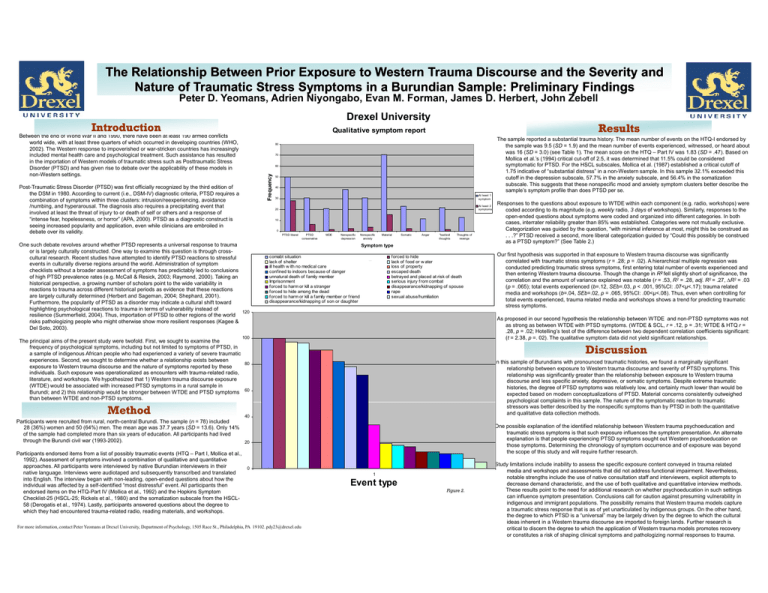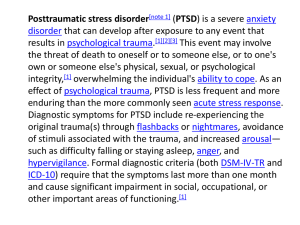The Relationship Between Prior Exposure to Western Trauma Discourse and...
advertisement

The Relationship Between Prior Exposure to Western Trauma Discourse and the Severity and Nature of Traumatic Stress Symptoms in a Burundian Sample: Preliminary Findings Peter D. Yeomans, Adrien Niyongabo, Evan M. Forman, James D. Herbert, John Zebell e e U University e s ty Drexel Introduction Results Qualitative symptom report Between the end of World War II and 1990, there have been at least 190 armed conflicts world wide, with at least three quarters of which occurred in developing countries (WHO, 2002). The Western response to impoverished or war-stricken countries has increasingly included mental health care and psychological treatment. Such assistance has resulted in the importation of Western models of traumatic stress such as Posttraumatic Stress Disorder (PTSD) and has given rise to debate over the applicability of these models in non-Western settings. The sample reported a substantial trauma history. The mean number of events on the HTQ-I endorsed by the sample was 9.5 (SD = 1.9) and the mean number of events experienced, witnessed, or heard about was 16 (SD = 3.0) (see Table 1). The mean score on the HTQ – Part IV was 1.83 (SD = .47). Based on Mollica et al.’s (1994) critical cut-off of 2.5, it was determined that 11.5% could be considered symptomatic for PTSD. For the HSCL subscales, Mollica et al. (1987) established a critical cutoff of 1.75 indicative of “substantial distress” in a non-Western sample. In this sample 32.1% exceeded this cutoff in the depression subscale, 57.7% in the anxiety subscale, and 56.4% in the somatization subscale. This suggests that these nonspecific mood and anxiety symptom clusters better describe the sample’s sample s symptom profile than does PTSD per se. se 80 70 Freq quency 60 Post-Traumatic Stress Disorder (PTSD) was first officially recognized by the third edition of the DSM in 1980. According to current (i.e., DSM-IV) diagnostic criteria, PTSD requires a combination of symptoms within three clusters: intrusion/reexperiencing, avoidance /numbing, and hyperarousal. The diagnosis also requires a precipitating event that involved at least the threat of injury to or death of self or others and a response of “intense fear, hopelessness, or horror” (APA, 2000). PTSD as a diagnostic construct is seeing increased popularity and application, even while clinicians are embroiled in debate over its validity. 50 40 30 At least 1 symptom 20 At least 2 symptoms 10 0 PTSD liberal One such debate revolves around whether PTSD represents a universal response to trauma or is largely culturally constructed. One way to examine this question is through crosscultural research. Recent studies have attempted to identify PTSD reactions to stressful events in culturally diverse regions around the world. Administration of symptom checklists without a broader assessment of symptoms has predictably led to conclusions of high PTSD prevalence rates (e.g. McCall & Resick, 2003; Raymond, 2000). Taking an historical perspective, a growing number of scholars point to the wide variability in reactions to trauma across different historical periods as evidence that these reactions are largely culturally determined (Herbert and Sageman, 2004; Shephard, 2001). Furthermore, the popularity of PTSD as a disorder may indicate a cultural shift toward highlighting psychological reactions to trauma in terms of vulnerability instead of 120 resilience (Summerfield, 2004). Thus, importation of PTSD to other regions of the world risks pathologizing people who might otherwise show more resilient responses (Kagee & Del Soto, 2003). PTSD conservative MDE Nonspecific depression Nonspecific anxiety Material Somatic Anger "bad/evil thoughts Thoughts of revenge Symptom type comabt situation lack of shelter ill health w ith no medical care confined to indoors because of danger unnatural death of family member Imprisonment forced to harm or kill a stranger forced to hide among the dead forced to harm or kill a family member or friend disappearance/kidnapping of son or daughter forced to hide lack of food or w ater Trauma History loss of property escaped death betrayed and placed at risk of death serious injury from combat disappearance/kidnapping of spouse rape sexual abuse/humiliation Figure 1. 100 The principal aims of the present study were twofold. First, we sought to examine the frequency of psychological symptoms, including but not limited to symptoms of PTSD, in a sample of indigenous African people who had experienced a variety of severe traumatic experiences. Second, we sought to determine whether a relationship exists between 80 exposure to Western trauma discourse and the nature of symptoms reported by these individuals. Such exposure was operationalized as encounters with trauma-related radio, literature, and workshops. We hypothesized that 1) Western trauma discourse exposure (WTDE) would be associated with increased PTSD symptoms in a rural sample in Burundi; and 2) this relationship would be stronger between WTDE and PTSD symptoms 60 than between WTDE and non-PTSD symptoms. Method As proposed in our second hypothesis the relationship between WTDE and non-PTSD symptoms was not as strong as between WTDE with PTSD symptoms. (WTDE & SCL, r = .12, p = .31; WTDE & HTQ r = .28, 28 p = .02; 02; Hotelling’s Hotelling s test of the difference between two dependent correlation coefficients significant: (t = 2.38, p =. 02). The qualitative symptom data did not yield significant relationships. Discussion 40 One possible explanation of the identified relationship between Western trauma psychoeducation and traumatic stress symptoms is that such exposure influences the symptom presentation. An alternate explanation is that people experiencing PTSD symptoms sought out Western psychoeducation on those symptoms. Determining the chronology of symptom occurrence and of exposure was beyond the scope of this study and will require further research. 0 For more information, contact Peter Yeomans at Drexel University, Department of Psychology, 1505 Race St., Philadelphia, PA 19102. pdy23@drexel.edu Our first hypothesis was supported in that exposure to Western trauma discourse was significantly correlated with traumatic stress symptoms (r = .28; 28; p = .02). 02) A hierarchical multiple regression was conducted predicting traumatic stress symptoms, first entering total number of events experienced and then entering Western trauma discourse. Though the change in R2 fell slightly short of significance, the correlation and the amount of variance explained was notable (r = .53, R2 = .28, adj. R2 = .27, ∆R2 = .03 (p = .065); total events experienced (b=.12, SEb=.03, p < .001, 95%CI: .07<μ<.17); trauma related media and workshops (b=.04, SEb=.02, p = .065, 95%CI: .00<μ<.08). Thus, even when controlling for total events experienced, trauma related media and workshops shows a trend for predicting traumatic stress symptoms. In this sample of Burundians with pronounced traumatic histories, we found a marginally significant relationship between exposure to Western trauma discourse and severity of PTSD symptoms. This relationship was significantly greater than the relationship between exposure to Western trauma discourse and less specific anxiety, depressive, or somatic symptoms. Despite extreme traumatic histories, the degree of PTSD symptoms was relatively low, and certainly much lower than would be expected based on modern conceptualizations of PTSD. Material concerns consistently outweighed psychological complaints in this sample. The nature of the symptomatic reaction to traumatic stressors was better described by the nonspecific symptoms than by PTSD in both the quantitative and qualitative data collection methods. Participants were recruited from rural, north-central Burundi. The sample (n = 78) included 28 (36%) women and 50 (64%) men. The mean age was 37.7 years (SD = 13.6). Only 14% of the sample had completed more than six years of education. All participants had lived through the Burundi civil war (1993-2002). 20 Participants endorsed items from a list of possibly traumatic events (HTQ – Part I, Mollica et al., 1992). Assessment of symptoms involved a combination of qualitative and quantitative approaches. All participants were interviewed by native Burundian interviewers in their native language. language Interviews were audiotaped and subsequently transcribed and translated into English. The interview began with non-leading, open-ended questions about how the individual was affected by a self-identified “most distressful” event. All participants then endorsed items on the HTQ-Part IV (Mollica et al., 1992) and the Hopkins Symptom Checklist-25 (HSCL-25; Rickels et al., 1980) and the somatization subscale from the HSCL58 (Derogatis et al., 1974). Lastly, participants answered questions about the degree to which they had encountered trauma-related radio, reading materials, and workshops. Responses to the questions about exposure to WTDE within each component (e.g. radio, workshops) were coded according to its magnitude (e.g. weekly radio, 3 days of workshops). Similarly, responses to the open-ended questions about symptoms were coded and organized into different categories. In both cases, interrater reliability greater than 85% was established. Categories were not mutually exclusive. Categorization was guided by the question, “with minimal inference at most, might this be construed as . . .?” PTSD received a second, more liberal categorization guided by “Could this possibly be construed as a PTSD symptom?” (See Table 2.) 1 Event type Figure 2. Study limitations include inability to assess the specific exposure content conveyed in trauma related media and workshops and assessments that did not address functional impairment. Nevertheless, notable strengths include the use of native consultation staff and interviewers, explicit attempts to decrease demand characteristic, and the use of both qualitative and quantitative interview methods. These results point to the need for additional research on whether psychoeducation in such settings can influence symptom presentation. Conclusions call for caution against presuming vulnerability in indigenous and immigrant populations. The possibility remains that Western trauma models capture a traumatic stress response that is as of yet unarticulated by indigenous groups. On the other hand, the degree to which PTSD is a “universal” may be largely driven by the degree to which the cultural ideas inherent in a Western trauma discourse are imported to foreign lands. Further research is critical to discern the degree to which the application of Western trauma models promotes recovery or constitutes a risk of shaping clinical symptoms and pathologizing normal responses to trauma.



